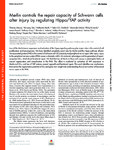The Merlin tumour suppressor controls the repair capacity of Schwann cells following injury by regulating Hippo pathway signalling
| dc.contributor.author | Mindos, T | |
| dc.contributor.author | Dun, X-P | |
| dc.contributor.author | North, K | |
| dc.contributor.author | Schulz, A | |
| dc.contributor.author | Gray, B | |
| dc.contributor.author | Pan, D | |
| dc.contributor.author | Edwards, P | |
| dc.contributor.author | Shivane, A | |
| dc.contributor.author | Morrison, H | |
| dc.contributor.author | Parkinson, D | |
| dc.date.accessioned | 2018-09-10T09:12:42Z | |
| dc.date.available | 2018-09-10T09:12:42Z | |
| dc.date.issued | 2017-01-30 | |
| dc.identifier.issn | 0021-9525 | |
| dc.identifier.issn | 1098-1136 | |
| dc.identifier.uri | http://hdl.handle.net/10026.1/12277 | |
| dc.description.abstract |
Loss of the Merlin tumor suppressor and activation of the Hippo signaling pathway play major roles in the control of cell proliferation and tumorigenesis. We have identified completely novel roles for Merlin and the Hippo pathway effector Yes-associated protein (YAP) in the control of Schwann cell (SC) plasticity and peripheral nerve repair after injury. Injury to the peripheral nervous system (PNS) causes a dramatic shift in SC molecular phenotype and the generation of repair-competent SCs, which direct functional repair. We find that loss of Merlin in these cells causes a catastrophic failure of axonal regeneration and remyelination in the PNS. This effect is mediated by activation of YAP expression in Merlin-null SCs, and loss of YAP restores axonal regrowth and functional repair. This work identifies new mechanisms that control the regenerative potential of SCs and gives new insight into understanding the correct control of functional nerve repair in the PNS. | |
| dc.format.extent | E40-E41 | |
| dc.language.iso | en | |
| dc.publisher | Rockefeller University Press | |
| dc.title | The Merlin tumour suppressor controls the repair capacity of Schwann cells following injury by regulating Hippo pathway signalling | |
| dc.type | journal-article | |
| dc.type | Meeting Abstract | |
| plymouth.author-url | https://www.webofscience.com/api/gateway?GWVersion=2&SrcApp=PARTNER_APP&SrcAuth=LinksAMR&KeyUT=WOS:000403071700060&DestLinkType=FullRecord&DestApp=ALL_WOS&UsrCustomerID=11bb513d99f797142bcfeffcc58ea008 | |
| plymouth.volume | 65 | |
| plymouth.publication-status | Published | |
| plymouth.journal | Journal of Cell Biology | |
| dc.identifier.doi | 10.1083/jcb.201606052 | |
| plymouth.organisational-group | /Plymouth | |
| plymouth.organisational-group | /Plymouth/Faculty of Health | |
| plymouth.organisational-group | /Plymouth/Faculty of Health/Peninsula Medical School | |
| plymouth.organisational-group | /Plymouth/REF 2021 Researchers by UoA | |
| plymouth.organisational-group | /Plymouth/REF 2021 Researchers by UoA/UoA01 Clinical Medicine | |
| plymouth.organisational-group | /Plymouth/REF 2021 Researchers by UoA/UoA03 Allied Health Professions, Dentistry, Nursing and Pharmacy | |
| plymouth.organisational-group | /Plymouth/Research Groups | |
| plymouth.organisational-group | /Plymouth/Research Groups/Institute of Translational and Stratified Medicine (ITSMED) | |
| plymouth.organisational-group | /Plymouth/Research Groups/Institute of Translational and Stratified Medicine (ITSMED)/CBR | |
| plymouth.organisational-group | /Plymouth/Users by role | |
| plymouth.organisational-group | /Plymouth/Users by role/Academics | |
| plymouth.organisational-group | /Plymouth/Users by role/Researchers in ResearchFish submission | |
| dcterms.dateAccepted | 2016-12-27 | |
| dc.identifier.eissn | 1098-1136 | |
| dc.rights.embargoperiod | Not known | |
| rioxxterms.versionofrecord | 10.1083/jcb.201606052 | |
| rioxxterms.licenseref.uri | http://www.rioxx.net/licenses/all-rights-reserved | |
| rioxxterms.licenseref.startdate | 2017-01-30 | |
| rioxxterms.type | Journal Article/Review |


